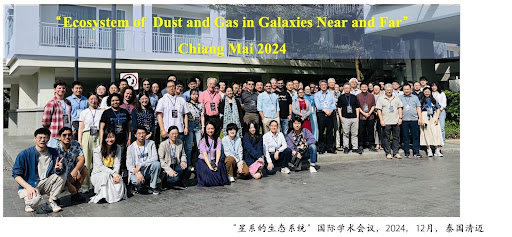
From December 10 to 15, 2024, the annual academic conference “Gas and Dust Ecosystems in Neighboring and Distant Galaxies” was successfully held in Chiang Mai, Thailand. This conference was co-hosted by the National Astronomical Observatories of the Chinese Academy of Sciences (NAOC), the South American Center for Astronomy of the Chinese Academy of Sciences, and the National Astronomical Research Institute of Thailand. It attracted more than 100 experts, young scholars, and students from over 30 astronomical research institutions, including the Chinese Academy of Sciences and domestic and international universities. The participants had in-depth exchanges and heated discussions on the latest advancements and future challenges in various frontier fields of astronomy.
At the opening ceremony, Researcher Dai Yu from the NAOC and Researcher Wiphu Rujopakarn from the National Astronomical Research Institute of Thailand delivered speeches to welcome participants from around the world. The conference featured eight thematic sessions over four days, including academic presentations and focused discussions on topics such as “Interactions between Active Galactic Nuclei (AGN) and Host Galaxies,” “AGN Accretion and Black Hole Growth over Cosmic Time,” “Galaxy and Star Formation in Cosmic Time,” “Ecosystems of Gas and Dust,” “Massive Galaxies and Quenching Processes,” “Connecting Simulations and Observations,” and “Galaxy Pairs, Proto-Clusters, and their Environments.” Participants shared their latest research findings, theoretical advancements, and discussed future directions.
The conference featured several renowned international astronomers as keynote speakers, including Professors Dimitra Rigopoulou and Roberto Maiolino from the University of Cambridge, Dr. Fengwu Sun from the Harvard-Smithsonian Center for Astrophysics, Dr. Mingyang Zhuang from the University of Illinois at Urbana-Champaign, Researcher Pablo Perez-Gonzalez from the Spanish Center for Astrobiology, Professor Haowei Yan from the University of Missouri, Dr. Yuri Nishimura from the University of Tokyo, Professor Zheng Cai from Tsinghua University, Researcher David Elbaz from the Saclay Nuclear Research Center, Professor Tao Wang from Nanjing University, Professor Feng Yuan from Fudan University, Professor Cheng Li from Tsinghua University, and Researcher Qi Guo from the NAOC. They delivered outstanding reports on cutting-edge topics, providing profound academic inspiration to the participants.
The conference concluded with a summary speech by Researcher Huang Jiasheng, Chief Scientist of the South American Center for Astronomy and NAOC. He highly praised the conference’s role in promoting international academic exchanges and collaboration and outlined the promising prospects of future astronomical research.
The successful convening of this academic conference not only provided a platform for global astronomers to exchange ideas and foster cooperation but also further promoted the integration and innovation of frontier astronomical research. As humanity continues to expand its understanding of the universe, studies on gas and dust will continue to unveil the mysteries of galaxy evolution, driving us toward deeper scientific exploration.













